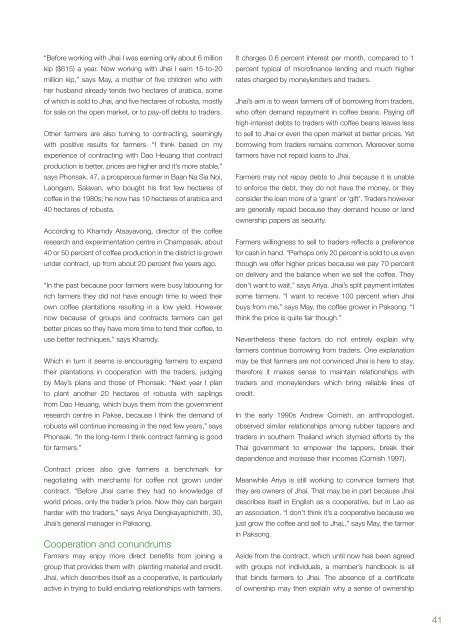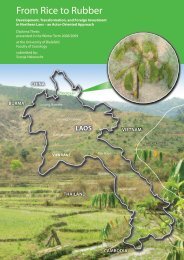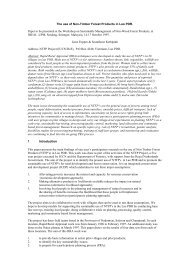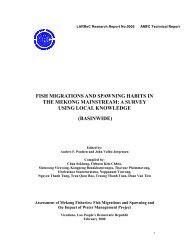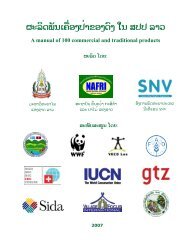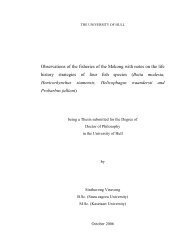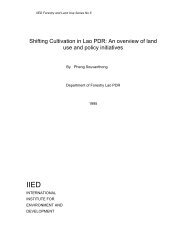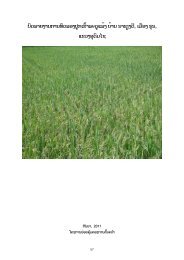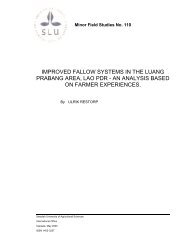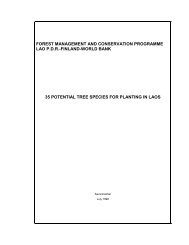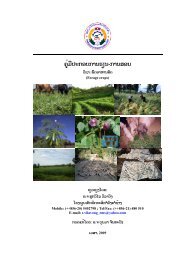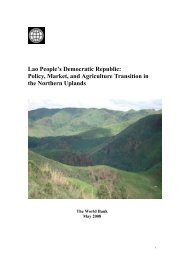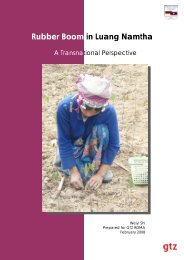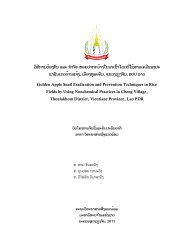Contract Farming in Lao PDR: Cases and Questions - LAD - nafri
Contract Farming in Lao PDR: Cases and Questions - LAD - nafri
Contract Farming in Lao PDR: Cases and Questions - LAD - nafri
Create successful ePaper yourself
Turn your PDF publications into a flip-book with our unique Google optimized e-Paper software.
“Before work<strong>in</strong>g with Jhai I was earn<strong>in</strong>g only about 6 million<br />
kip ($615) a year. Now work<strong>in</strong>g with Jhai I earn 15-to-20<br />
million kip,” says May, a mother of five children who with<br />
her husb<strong>and</strong> already tends two hectares of arabica, some<br />
of which is sold to Jhai, <strong>and</strong> five hectares of robusta, mostly<br />
for sale on the open market, or to pay-off debts to traders.<br />
Other farmers are also turn<strong>in</strong>g to contract<strong>in</strong>g, seem<strong>in</strong>gly<br />
with positive results for farmers. “I th<strong>in</strong>k based on my<br />
experience of contract<strong>in</strong>g with Dao Heuang that contract<br />
production is better, prices are higher <strong>and</strong> it’s more stable,”<br />
says Phonsak, 47, a prosperous farmer <strong>in</strong> Baan Na Sia Noi,<br />
<strong>Lao</strong>ngam, Salavan, who bought his first few hectares of<br />
coffee <strong>in</strong> the 1980s; he now has 10 hectares of arabica <strong>and</strong><br />
40 hectares of robusta.<br />
Accord<strong>in</strong>g to Khamdy Atsayavong, director of the coffee<br />
research <strong>and</strong> experimentation centre <strong>in</strong> Champasak, about<br />
40 or 50 percent of coffee production <strong>in</strong> the district is grown<br />
under contract, up from about 20 percent five years ago.<br />
“In the past because poor farmers were busy labour<strong>in</strong>g for<br />
rich farmers they did not have enough time to weed their<br />
own coffee plantations result<strong>in</strong>g <strong>in</strong> a low yield. However<br />
now because of groups <strong>and</strong> contracts farmers can get<br />
better prices so they have more time to tend their coffee, to<br />
use better techniques,” says Khamdy.<br />
Which <strong>in</strong> turn it seems is encourag<strong>in</strong>g farmers to exp<strong>and</strong><br />
their plantations <strong>in</strong> cooperation with the traders, judg<strong>in</strong>g<br />
by May’s plans <strong>and</strong> those of Phonsak: “Next year I plan<br />
to plant another 20 hectares of robusta with sapl<strong>in</strong>gs<br />
from Dao Heuang, which buys them from the government<br />
research centre <strong>in</strong> Pakse, because I th<strong>in</strong>k the dem<strong>and</strong> of<br />
robusta will cont<strong>in</strong>ue <strong>in</strong>creas<strong>in</strong>g <strong>in</strong> the next few years,” says<br />
Phonsak. “In the long-term I th<strong>in</strong>k contract farm<strong>in</strong>g is good<br />
for farmers.”<br />
<strong>Contract</strong> prices also give farmers a benchmark for<br />
negotiat<strong>in</strong>g with merchants for coffee not grown under<br />
contract. “Before Jhai came they had no knowledge of<br />
world prices, only the trader’s price. Now they can barga<strong>in</strong><br />
harder with the traders,” says Ariya Dengkayaphichith, 30,<br />
Jhai’s general manager <strong>in</strong> Paksong.<br />
Cooperation <strong>and</strong> conundrums<br />
Farmers may enjoy more direct benefits from jo<strong>in</strong><strong>in</strong>g a<br />
group that provides them with plant<strong>in</strong>g material <strong>and</strong> credit.<br />
Jhai, which describes itself as a cooperative, is particularly<br />
active <strong>in</strong> try<strong>in</strong>g to build endur<strong>in</strong>g relationships with farmers.<br />
It charges 0.6 percent <strong>in</strong>terest per month, compared to 1<br />
percent typical of microf<strong>in</strong>ance lend<strong>in</strong>g <strong>and</strong> much higher<br />
rates charged by moneylenders <strong>and</strong> traders.<br />
Jhai’s aim is to wean farmers off of borrow<strong>in</strong>g from traders,<br />
who often dem<strong>and</strong> repayment <strong>in</strong> coffee beans. Pay<strong>in</strong>g off<br />
high-<strong>in</strong>terest debts to traders with coffee beans leaves less<br />
to sell to Jhai or even the open market at better prices. Yet<br />
borrow<strong>in</strong>g from traders rema<strong>in</strong>s common. Moreover some<br />
farmers have not repaid loans to Jhai.<br />
Farmers may not repay debts to Jhai because it is unable<br />
to enforce the debt, they do not have the money, or they<br />
consider the loan more of a ‘grant’ or ‘gift’. Traders however<br />
are generally repaid because they dem<strong>and</strong> house or l<strong>and</strong><br />
ownership papers as security.<br />
Farmers will<strong>in</strong>gness to sell to traders reflects a preference<br />
for cash <strong>in</strong> h<strong>and</strong>. “Perhaps only 20 percent is sold to us even<br />
though we offer higher prices because we pay 70 percent<br />
on delivery <strong>and</strong> the balance when we sell the coffee. They<br />
don’t want to wait,” says Ariya. Jhai’s split payment irritates<br />
some farmers. “I want to receive 100 percent when Jhai<br />
buys from me,” says May, the coffee grower <strong>in</strong> Paksong. “I<br />
th<strong>in</strong>k the price is quite fair though.”<br />
Nevertheless these factors do not entirely expla<strong>in</strong> why<br />
farmers cont<strong>in</strong>ue borrow<strong>in</strong>g from traders. One explanation<br />
may be that farmers are not conv<strong>in</strong>ced Jhai is here to stay,<br />
therefore it makes sense to ma<strong>in</strong>ta<strong>in</strong> relationships with<br />
traders <strong>and</strong> moneylenders which br<strong>in</strong>g reliable l<strong>in</strong>es of<br />
credit.<br />
In the early 1990s Andrew Cornish, an anthropologist,<br />
observed similar relationships among rubber tappers <strong>and</strong><br />
traders <strong>in</strong> southern Thail<strong>and</strong> which stymied efforts by the<br />
Thai government to empower the tappers, break their<br />
dependence <strong>and</strong> <strong>in</strong>crease their <strong>in</strong>comes (Cornish 1997).<br />
Meanwhile Ariya is still work<strong>in</strong>g to conv<strong>in</strong>ce farmers that<br />
they are owners of Jhai. That may be <strong>in</strong> part because Jhai<br />
describes itself <strong>in</strong> English as a cooperative, but <strong>in</strong> <strong>Lao</strong> as<br />
an association. “I don’t th<strong>in</strong>k it’s a cooperative because we<br />
just grow the coffee <strong>and</strong> sell to Jhai,,” says May, the farmer<br />
<strong>in</strong> Paksong.<br />
Aside from the contract, which until now has been agreed<br />
with groups not <strong>in</strong>dividuals, a member’s h<strong>and</strong>book is all<br />
that b<strong>in</strong>ds farmers to Jhai. The absence of a certificate<br />
of ownership may then expla<strong>in</strong> why a sense of ownership<br />
41


